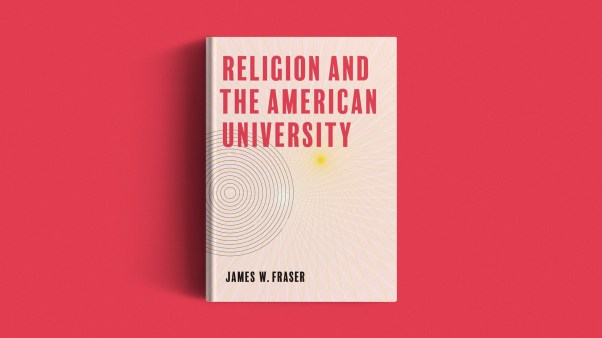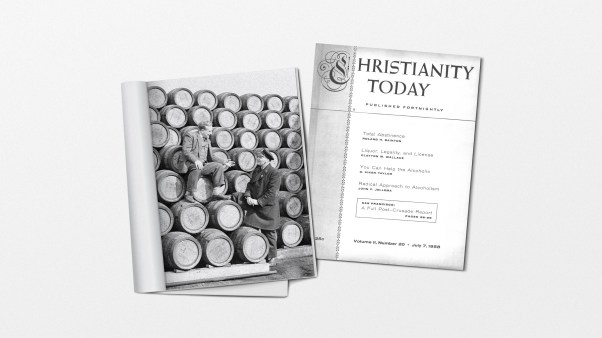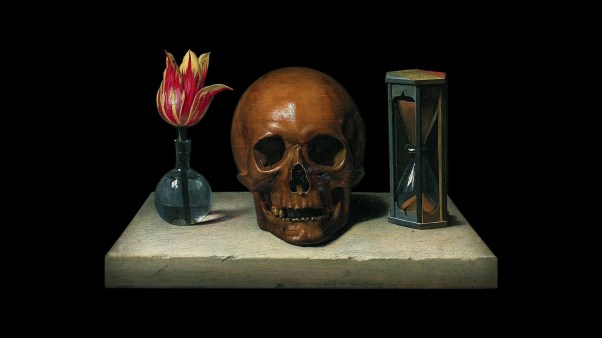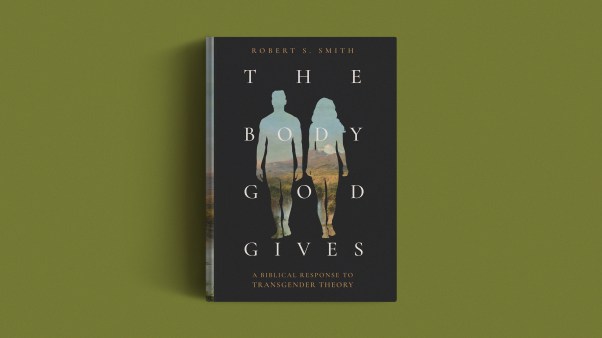I had to think a lot about death recently when my older brother, a missionary in Japan, came home. I went down to Oregon for a visit with him and the rest of my family, who all live there. It was a good visit to the farm where I grew up, which borders the South Santiam River for a mile or so. And though the woods were fragrant with the scent of spring—particularly the smell of cottonwood buds, which are like a sweet, sticky perfume—there was still a deep awareness of death in the visit.
There was the fact that Sue, my younger brother's wife, had died last summer, leaving four teenage children, and my brother's family is still in deep grief. Also, my wife, Mary Ruth, wasn't with me on this trip as she had gone to Illinois to be with her mother who was recovering from a stroke. At the same time, Mary Ruth's nine-year old nephew was in the hospital fighting a staph infection that could take his leg, and quite possibly, his life.
The farm itself was a reminder of death. It has been in steady decline since my father died over 20 years ago. But more than that was the immediate reason for the visit, the need for my brothers and sister and me to talk about the future of this piece of land. After my father's death, my mother gave it to her four children. My younger brother, who lives there, owns the cleared land. My sister, older brother, and I own the rest of the land: 150 acres of forest along the river, that same forest that in green leaves and fragrant buds and the chorus of a million frogs was coming to life while I was visiting.
But though spring and new life returns every year to that place of my childhood in Oregon—as it does so dramatically everywhere in the Northern Hemisphere—we are all older. Nature goes in cycles, but we live our lives in a line, from birth to death.
Although widowed years ago, my mother is still in good health. She still hauls in wood from the woodshed to keep her house warm, cooks large meals for large gatherings of children, grandchildren, and great-grandchildren. But she is in her mideighties and cannot have too many years left.
My brothers and sister and I spent part of our time in a lawyer's office, facing the prospect of our own death. Perhaps it makes some sense for three grown children to own together a piece of their parents' land. It makes little sense, however, for eight grandchildren to do so, or 20 great-grandchildren. So we were discussing options, such as putting the land in the perpetual ownership of a trust or company. But in doing that we had to come to terms with the fact that the very ties of father and children that made the land so important to us were passing away: it will mean less and less to future generations.
Gerard Manley Hopkins wrote in a poem not long before his own early death that "Million-fueled, nature's bonfire burns on," yet "Man, how fast his firedint, his mark on mind, is gone!" But that fire of life that returns every year after winter is little comfort to us who have experienced the death of those close to us. (Bonfire, after all, means bone-fire, a quick, safe way of getting rid of the dead.) We are likely rather to echo Martha's words: "Lord, if you had been here, my brother [Lazarus] would not have died" (John 11:21, NRSV).
One of the comforts—and problems—in our celebration of Easter is that it always happens in the spring. Unlike Jesus' birth, whose time of the year we don't know, Jesus' death and resurrection took place at the time of the Jewish Passover, which is always in the spring.
Thus this Christian celebration of new life seems in some ways to echo pagan ways of coming to terms with death by making it simply part of the cycle, the eternal round of death and life. (The word Easter itself comes from Oestre, the name of a Teutonic goddess whose festival was at the spring equinox.) So how are the life and death of people—or the life and death of vegetation—related to the life, death, and resurrection of Jesus?
As I think about that question in the shadows of death that lie across my own family, I keep remembering last spring, part of the six months we spent in Scotland in the ancient university town of Saint Andrews. We lived in a pleasant, second-floor flat in a stone house whose south-facing window looks across a wall and a huge cemetery toward a ruined tower of Saint Andrews cathedral. Only one wall remains of the church (through its empty arches we watched the slow spring brighten the fertile hills to the south).
When we moved in, we noticed signs of construction work in the corner of the cemetery just below our window. We learned that a tall cross honoring this century's war dead had been dismantled in order to have its foundations replaced. One morning we heard heavy equipment below our window and looked out to see a backhoe cautiously digging in the disturbed earth where the cross had been. A grey-haired woman in a raincoat watched intently. Over the next few days, as the hole went deeper, we watched as she and two assistants, with brush and trowel, gently uncovered skeleton after skeleton, carefully lifting the brittle bones and placing them in plastic bags for burial elsewhere.
Once we stopped and talked to the archaeologists who were commissioned by the city to remove all bones beneath the monument. They were delicately brushing the dirt away from two long-legged skeletons, carefully laid side by side. "Twelfth to fourteenth century," they said. Any sign of a coffin? "No, they would have been buried in shrouds at that date." Any artifacts? "No, we never find artifacts in a Christian burial."
They knew, though, that the earth would yield bones: nameless, unidentified, they were nevertheless inevitable, in the shadow of a once-great church. "Are they not continually putting distemper'd corpses within you?" asked Walt Whitman of the earth. "It gives such divine materials to men, and accepts such leavings from them at last."
The hole, with bones removed, was there for months. When the weather got warmer, I took a few bucketsful of the moist, bone-rich dirt and filled a planter-box by the door. The stocks and sweet peas I planted in it, especially fragrant at night, were still blooming when we left in July.
It was, I suppose, a resurrection of sorts for those old bones. Such "resurrections" happen every spring. But is that what the Resurrection means?
On Easter Sunday evening in Scotland we joined hundreds of students and townspeople on the grass of what had once been the interior of the cathedral. We were given burning torches. The red flames lit up the old stone of the one remaining wall with an eerie suggestion that the old cathedral was still there. Then we walked through the town singing, and shouting between the songs, "Christ is risen—he is risen indeed." One song we sang was:
Now the green blade riseth from the
buried grain,
Wheat that in the dark earth many
days hath lain
Love lives again, that with the dead
has been;
Love is come again, like wheat that
springeth green . …
Forth He came at Easter, like the
risen grain,
He that for three days in the grave
had lain.
Quick from the dead my risen Lord
is seen;
Love is come again, like wheat that
springeth green.
It is a beautiful hymn—and a little troubling. Is the Christian celebration of Jesus' resurrection just the Christian way of being glad about the return of spring? That's not what the hymn says, of course. But I wonder how many people who sing it think more about the resurrection of the spring than the resurrection of Jesus?
Part of us would be more comfortable with Jesus as a wise teacher than the one who conquered death.
In any case, there is a distressing tendency, especially in the twentieth century, to reduce the Resurrection to something we can be more comfortable with. Though the hope of our own resurrection is a comfort, the thought of Jesus' resurrection raises some distinctly discomforting possibilities for us.
Part of us would be more comfortable with Jesus as a wise teacher than the one who conquered death. Because if Jesus conquered death, then we have to take very seriously what the whole story of the Bible says death is for us: the wages of sin. It would be easier for us to think of the Resurrection as something like the return of spring, a symbolic way of saying that the same thing will happen again and again—including our own sin, which may bring a kind of death with it. But maybe sin too will be healed by time, as the wounds of winter are healed by spring. The historic reality of Jesus' resurrection, however, underlines the inescapable reality of our own sin.
In Scotland we worshiped in a church that was, at first, a great blessing to us. On the Sunday after our Easter walk through the town shouting "Christ is risen," the regular minister was on vacation and an associate preached. He began by referring to the discovery—which made headlines that year—of three boxes of bones at a cemetery in Palestine, bearing the names of Jesus, Mary, and Lazarus. His point was that though we don't know whether those were the bones of the Jesus of the New Testament, it wouldn't really matter if they were. He quoted an Anglican bishop: "God isn't interested in conjuring tricks with bones" and went on to say that Easter is more important than whether Jesus physically was raised from the dead. What Easter means instead is that the Spirit of Christ blossoms wherever we go, in that new life that is symbolized by the return every year of flowers and green from the grave of the earth. Remember "Now the green blade riseth"?
We had just confessed our faith in Jesus' resurrection in the words of the Apostles' Creed, and we all had, in one way or another, celebrated the Resurrection the week before. So it seemed a little odd to be hearing that it didn't matter if the bones of Jesus were still in a box somewhere.
After some consideration, we wrote a letter to the regular minister expressing concern about the way the associate's sermon seemed to empty any real meaning out of the Resurrection that had been so gloriously remembered the week before. Later that week Mary Ruth mentioned the same concern in a women's group she had been attending. What was distressing was the response to our concern. The pastor, who came and visited us, was not concerned about the sermon but about how he could set our minds at rest. "I know members of my congregation who have experienced the living Christ in the past year," he said. "Who am I to deny that experience to the disciples?" That was as close as he got to affirming the physical reality of the Resurrection.
The women in the group were almost without exception concerned about Mary Ruth's reaction. For the next two weeks, various ones would call or drop by our apartment, and the burden of their conversation was almost always the same: Your faith is weak if it needs a physical resurrection of Jesus; strong faith needs no such crutch.
That response is typical: we live in a time that is rapidly dissolving all truths, including the truth of the Resurrection, into a matter of personal belief and preference. And in the spring, it is all too easy to reduce the empty tomb to a symbol of returning life, bending the stark uniqueness of the event back into the cycles of nature.
But that choice is not really open to Christians. Paul said it most succinctly: "If Christ has not been raised, then our proclamation has been in vain and your faith has been in vain" (1 Cor. 15:14, NRSV). John Updike made a similar point:
Make no mistake: if He rose at all
it was as His body;
if the cells' dissolution did not reverse,
the molecules reknit, the amino
acids rekindle,
the Church will fall.
It was not as the flowers,
each soft Spring recurrent;
it was not as his Spirit in the mouths
and fuddled eyes of the eleven
apostles; …
Let us not mock God with metaphor,
analogy, sidestepping transcendence;
making of the event a parable, a sign
painted in the faded credulity of
earlier ages:
let us walk through the door.
The stone is rolled back …
(from "Seven Stanzas at Easter")
We must not (as Updike goes on to say) "be embarrassed by the miracle," by the promise it gives us that in Christ neither our sin, nor our death, places us beyond God's love.
The miracle of Easter is vastly more than the miracle of "the flowers, each soft spring recurrent." But it is not separate from that miracle, either. For the Cross and the Resurrection, these great events of God's love, stand at the center of the whole creation. We are surrounded in everyday life by all sorts of little resurrections: from the new life in the flowers and trees around us, to the healing and forgiveness that make human relationship in families and friendships even possible.
Sometimes, as we have seen, it is tempting to make the Resurrection nothing more than a kind of symbol of that miracle. But the Christian gospel proclaims the exact opposite to that. It is rather that all life—from flowers to forgiveness—is rooted in God's self-giving love, in the "lamb slain before the foundation of the world." The self-emptying of God is the foundation of creation. It is that costly, inexhaustible gift that we sense in a spring wood. "Through him all things were made." The death and resurrection of Jesus is not a symbol of the greater reality of natural renewal; rather, nature in its burgeoning life is a reminder of this one event that makes plain that the whole miracle of creation is rooted in the self-giving love of God, a self-giving that for our sake came to a bloody focus on the hill outside Jerusalem. In that love, says Paul, "all things hold together. … For in him all the fullness of God was pleased to dwell, and through him God was pleased to reconcile to himself all things, whether on earth or in heaven, by making peace through the blood of his cross" (Col. 1:17b, 19-20).
The death and resurrection of Jesus is not a copy of a pattern in nature. Rather, nature gives us a partial picture of the love of God.
Many of these truths were brought home to Mary Ruth and me in a profound way a couple of weeks before that disturbing Sunday-after-Easter sermon. To our own surprise, we joined one of several small groups of Christians in the north of Britain who spend the week before Easter carrying a cross, 15 to 20 miles a day, converging on the morning of Good Friday on the sands outside Lindisfarne, a ruined reminder of one of the great missionary movements of the church in the seventh and eighth centuries.
I had been doing some research on early Celtic Christianity and had been thinking about the rich symbolism of the Celtic cross in its apparent juxtaposition of the pagan circle with the historic event of the crucifixion. It was through that research that I found out about this pilgrimage. We joined it, with some reluctance and misgiving: good Protestants as we are, we were more comfortable with cross-carrying and pilgrimage if it stayed safely in the language of devotion. "I'll come," said Mary Ruth, "but at the first sign of anything touchy-feely, I'm going home."
Part of each day, at a break for tea in the morning and the afternoon, persons in the group shared thoughts on the reasons and meaning of the pilgrimage. After that we would walk for half an hour in silence. Usually three people carried the cross, fullsized and large enough to be crucified on.
I took my turn at cross bearing, the first time self-consciously. But as soon as I started carrying that weight, the reading and writing I had been doing became concentrated in that hard, stark symbol. We were walking along an old road in the early spring. Snowdrops bloomed by the stone wall, and on the other side new lambs were bleating. What was the cross, that grim artifact of Roman history, doing here, surrounded by the great circle of spring in the Scottish border country?
I found first of all that I could not do this superficially. To carry the cross through that landscape was a way of reflecting powerfully on the truth that the death of Jesus on that instrument of torture was both the means of my relationship with God and the emblem of the very love that sustains the world. It was the center of the circle of that horizon, and of every horizon. Then we started singing: "Jesus, remember me, when you come into your kingdom," and I was moved without warning from reflection to wonder to worship.
There were many reminders of death on that weeklong walk—old battlefields, ruined abbeys, many cemeteries. The soil was full of blood and bones, as it was outside our window in Saint Andrews. But we were thinking also of the Resurrection: Jesus' resurrection, and ours, and the promise of a renewed creation where the last enemy destroyed will be death itself.
It is true, in the words of Hopkins's poem, that "million-fuel d, nature's bonfireburns" will burn each of us to ashes and bone. That is the other side, the autumn side of the joyous hope of spring. But placing the Cross, the eternal gift of God, at the center of those cycles of creation—in Oregon, in Scotland, in the yearly cycles of our own lives—points back to that central event of Jesus' death and resurrection. And it points as well outside the cycles of nature entirely, to the costly love of God.
So Hopkins's poem does not end with the awareness that, humanly speaking, "all is in an enormous dark Drowned." Rather, that poem (with the wonderful title, "That Nature Is a Heraclitean Fire and of the Comfort of the Resurrection") ends thus:
Enough! the Resurrection,
A heart's clarion! …
In a flash, at a trumpet crash,
I am all at once what Christ is, since
he was what I am, and
This Jack, joke, poor potsherd, patch,
matchwood, immortal diamond,
Is immortal diamond.
Loren Wilkinson is professor of philosophy and interdisciplinary studies at Regent College, Vancouver, British Columbia. This article was adapted from a sermon given in chapel at Regent College in 1997.
Copyright © 1999 Christianity Today. Click for reprint information.










